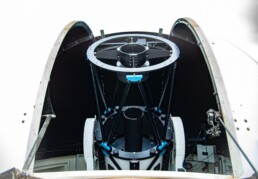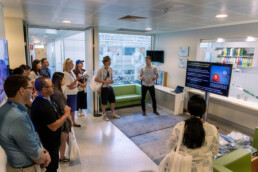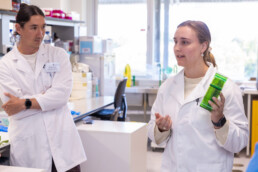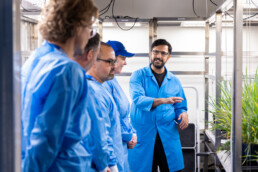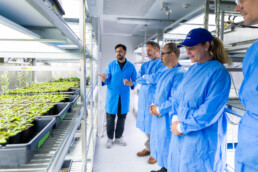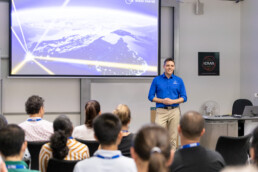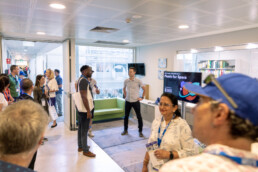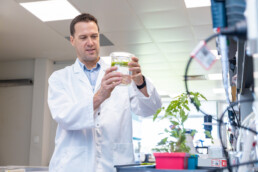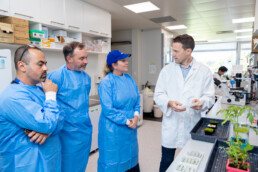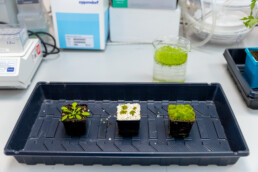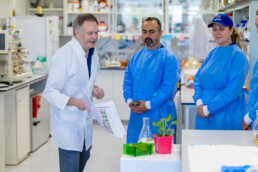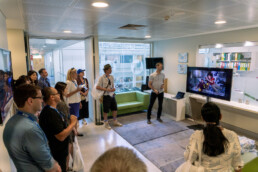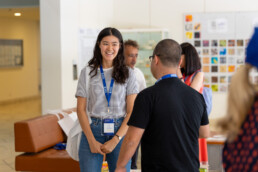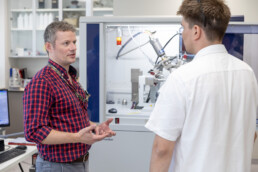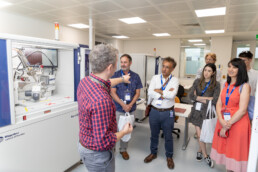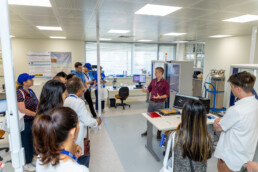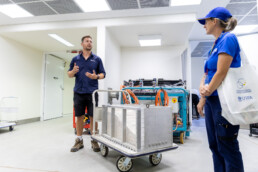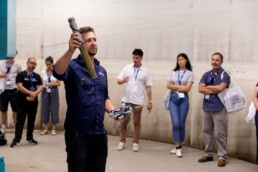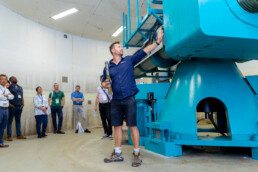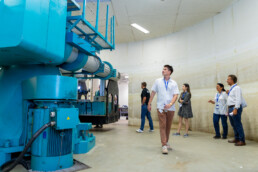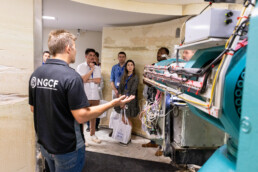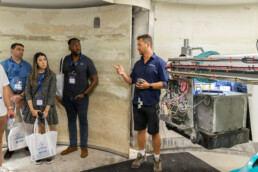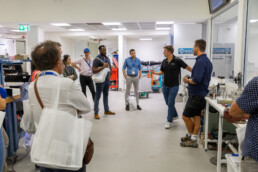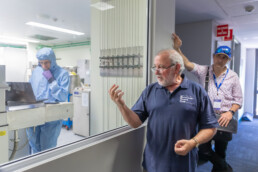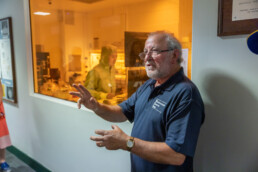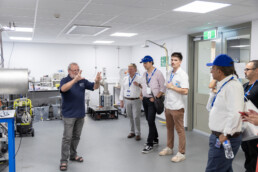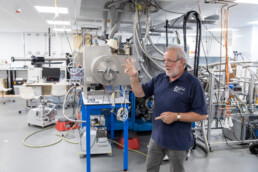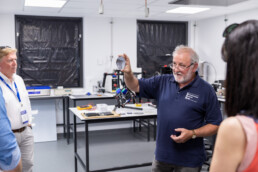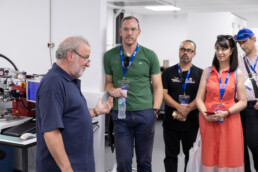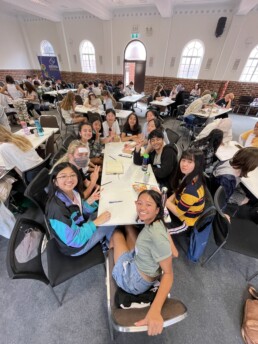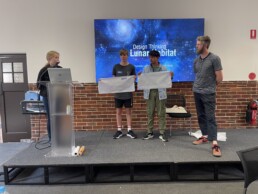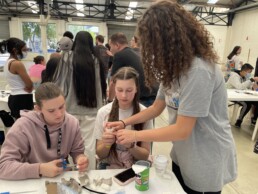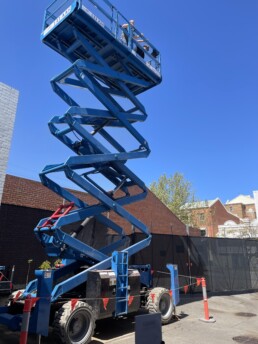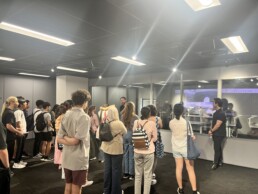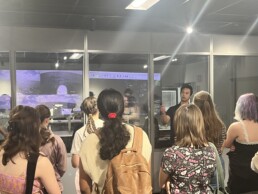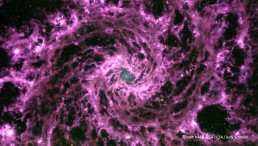$6.5m boost for WA space laser network to support lunar comms
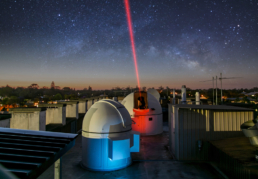
A UWA laser communications team has received a multi-million dollar grant from the Australian Space Agency to build a sovereign communications network that can send high-speed data to and from objects in space. WA’s Department of Jobs, Tourism, Science and Innovation supported the bid with $500,000, as did the University of Western Australia, making this a truly collaborative project between university, government and industry.
The $6.5 million project, which has just received a $4.4 million grant from the ASA as part of their support of NASA’s Moon to Mars initiative, will employ a new technology that uses super-fast lasers to talk to satellites and spacecraft at the International Centre for Radio Astronomy Research (ICRAR).
It’s called ‘free-space optical communications’, and is 1000 times faster than the radio communications currently used to communicate in space. The team form the Laser Communications and Timing Node of UWA’s International Space Centre.
Project leader Associate Professor Sascha Schediwy is a world expert in optical communications. He said the project—called TeraNet—will be one of the first commercial optical communications networks in Australia.
The network will be capable of providing day-to-day support to missions in space.
Schediwy says the network’s main commercial application will be transferring data to and from satellites orbiting the planet.
But the team also plans to develop capacity for high-speed communications to the lunar surface and beyond.
“It’s about supporting all these different customers and space missions in low Earth orbit,” Schediwy said.
“And then also being capable of advanced communications for things like NASA’s Artemis missions to the Moon.”
It means West Australian technology could transmit images from the first woman and first person of colour to land on the lunar surface.
The network will be made up of two fixed ground stations at UWA and Mingenew, and a third mobile station initially deployed at ESA’s New Norcia Deep Space Network.
Schediwy said NASA, ESA and other space agencies need communication stations worldwide to maintain continuous contact with missions as the Earth rotates.
“Western Australia’s geography and climate means it’s one of the best places in the world to host these ground stations,” he said. Western Australia is also positioned with a unique view of the sky inaccessible by our northern hemisphere neighbours.
Schediwy’s team will build the network with industry partners Goonhilly Australia and Thales Australia.
Goonhilly Earth Station chief executive Ian Jones said the company has collaborated with Schediwy and the UWA team for a few years to develop coherent optical ground-to-space communications.
“We are delighted to now see this move to the next exciting phase where we can assist in turning this into a technically mission-ready and commercially-operational service, especially for lunar communication,” he said.
“Goonhilly is the global pioneer in commercialising lunar communications and UWA is the world leader in this technology.
“This is precisely the reason we intend to grow our business in Western Australia and help to develop the lunar economy and the Australian space economy.”
“We have this leapfrog opportunity to get there first and develop this sovereign capability,” he said.
“And we can reap the benefits of having Australian industries and Australian researchers involved from day one.”
Australian Space Agency head Enrico Palermo agreed, and said the projects supported by the Agency show some of the many ways space technologies are improving how we live and work.
“By helping Australian organisations to develop their space heritage, they can break into new markets and supply chains and take their innovative Aussie technology to the world,” he said.
“That will help them to grow, keep their ideas in Australia and generate more employment opportunities here.”
The ASA’s Demonstrator Mission Grants support Australian businesses and researchers to develop space projects with a clear potential to support NASA’s inspirational endeavour to go forward to the Moon and then go on to Mars.
MORE INFORMATION
Leading the way in space research, capabilities and education at the University of Western Australia.
ICRAR
The International Centre for Radio Astronomy Research (ICRAR) is a joint venture between Curtin University and The University of Western Australia with support and funding from the State Government of Western Australia.
Department of Jobs, Tourism, Science and Innovation
JTSI are responsible for supporting the growth of the West Australian space sector to create jobs, diversify the economy, drive innovation and create a passion for STEM.

Goonhilly Earth Station has been the pioneering home of satellite communications since 1962. It continues to be recognised as a premier ground station of choice for the world’s major satellite operators, and has expanded its services to include lunar and deep space communications.
Thales Australia
Thales Australia is a trusted partner of the Australian Defence Force and is also present in commercial sectors ranging from air traffic management and ground transport systems to security systems and services. Thales Australia employs around 3,800 people directly and supports over 2,051 jobs along its Australian supply chain.
Thales Australia has a history of patient investment to build advanced in-country capability across manufacturing, critical systems and services. Close collaborative relationships with local customers, Australian SME suppliers and research institutions combined with technology transfer from our global business enables Thales to tailor high-quality solutions for Australian and export markets, generating revenue of $1.6 billion in exports over the past 10 years.
Geosience Australia
Geoscience Australia is the nation’s trusted source of information on Australia’s earth sciences.
We apply science and technology to describe and understand the Earth and we support evidence-based decisions by government, communities and industry through information, advice and services for a strong economy, resilient society and sustainable environment.
MULTIMEDIA
Video and images are available from Dropbox.
INTERVIEWS
Benjamin Dix-Matthews | benjamin.dix-matthews@uwa.edu.au | +61 402 499 263
MEDIA SUPPORT
Charlene D’Monte
ICRAR Media Contact | charlene.dmonte@icrar.org | +61 468 579 311| +61 8 6488 7758
Annelies Gartner
UWA University | annelies.gartner@uwa.edu.au| +61 8 6488 3229
Larissa Wiese
International Space Centre | riss.wiese@uwa.edu.au | +61 466 656 260
Protecting astronaut vision in long haul spaceflights
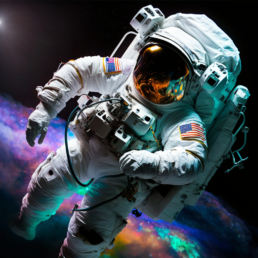
West Australian researchers have developed a breakthrough method to measure the brain fluid pressure in humans, which may reduce vision damage experienced by astronauts on long-haul space flights.
A cross-disciplinary team from the Lions Eye Institute (LEI) and the International Space Centre (ISC) at The University of Western Australia has developed a clever technique to measure the pressure in the brain fluid. This breakthrough study has been published today by Nature in njp Microgravity.
Co-author Danail Obreschkow, Associate Professor at the International Centre for Radio Astronomy Research and ISC Director, said, “These results may prove crucial to overcoming a type of blindness that frequently develops in astronauts on long-duration space flights.”
“The so-called Space Associated Neuro-ocular Syndrome (SANS) is one of the most serious risks for astronauts on long-duration flights,” elaborated LEI Director and lead-author Professor Bill Morgan. “NASA has identified SANS as a significant challenge on future crewed missions to Mars, and our study may help overcome this challenge.”
Our bodies evolved to counter the effects of gravity by pushing blood upwards into the head. In microgravity, this can lead to an increased average pressure in the cerebrospinal fluid (CSF), which adversely affects the retina. This deteriorates vision and other important functions. Until recently, CSF pressure could only be detected through invasive methods such as a lumbar puncture or skull burr hole. Both techniques are painful, risky, and cannot be performed well in microgravity.
The researchers have now developed a space-safe and non-invasive method to measure CSF pressure changes.
“All blood vessels experience tiny pulsations coming from the heartbeat. The strength of these pulsations in the tiny veins of the retina should, in principle, depend on the CSF pressure,” said Morgan.
In the study published today, the researchers succeeded at measuring these tiny pulsation changes in human subjects. They used a special eye camera to measure the vein pulsations while the subjects were put into different positions on a tilt-table. This approached allowed the scientists to mimic the effects of variable gravity on the CSF pressure.
Tilt table experiments on Earth are the only way of controllably altering the gravitational force upon the human body and allow researchers to alter the CSF pressure in small definite increments. This allows us to test systems for measuring that incremental change. It also forces us to develop systems which can be used in any postural position necessitating portable, small handheld devices which are essential if such systems are to be used in space.
The new findings provide a basis for the use of a handheld portable non-invasive device in microgravity conditions that can monitor intracranial pressure.
Better monitoring and testing in space of SANS progression will improve astronaut health in long-haul flights.
10 Million Hours of Supercomputing Time
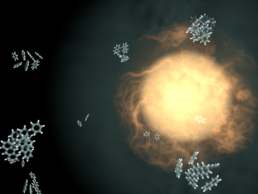
What would you do with almost 10 million computing hours at Australia’s most powerful public research computer, Pawsey Supercomputing Centre?
The ISC and The University of Western Australia’s School of Molecular Science’s Dr Dino Spagnoli has been awarded 4 million hours through the National Computational Merit Allocation Scheme (NCMAS) and a further 5.9 million hours through the Pawsey Partner Scheme.
Dr Spagnoli will be researching projects including interrogating the mineralogy of Titan, and simulating the formation of dust particles in the interstellar medium, requiring some pretty hard core computer power.
Dr Dino Spagnoli and Nicholas Stapleton are part of our Space Crystallography Node led by Professor Stephen Moggach.
https://pubs.rsc.org/en/content/articlelanding/2020/CP/D0CP02622K
Abstract
The relatively weak London dispersion forces are the only interactions that could cause aggregation between simple aromatic molecules. The use of molecular dynamics and high-level ab initio computer simulations has been used to describe the aggregation and interactions between molecular systems containing benzene, naphthalene and anthracene. Mixtures containing one type of molecule (homogenous) and more than one type of molecule (heterogenous) were considered. Our results indicate that as molecular weight increases so does the temperature at which aggregation will occur. In all simulations, the mechanism of aggregation is through small clusters coalescing into larger clusters. The structural analysis of the molecules within the clusters reveals that benzene will orient itself in T-shaped and parallel displaced configurations. Molecules of anthracene prefer to orient themselves in a similar manner to a bulk crystal with no T-shaped configuration observed. The aggregation of these aromatic molecules is discussed in the context of astrochemistry with particular reference to the dust formation region around stars.
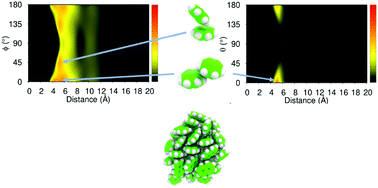
Thomas, M., Suarez-Martinez, I., Yu, L-J., Karton, A., Chandler, G. S., Robinson, M., Cherchneff, I., Talbi, D., & Spagnoli, D. (2020). Atomistic simulations of the aggregation of small aromatic molecules in homogenous and heterogenous mixtures. Physical Chemistry Chemical Physics, 22(37), 21005-21014. https://doi.org/10.1039/d0cp02622k
ISC's Inaugural Industry Tour
The ISC welcomed guests from government, industry and academia on Friday, February 3 to tour six of our 23 space Nodes across the UWA campus. We were delighted to demonstrate the capabilities of our researchers to such an interested, excited audience!
Our guests viewed Plants for Space, Space Crystallography, National Geotechnical Centrifuge Facility, IT and Robotics in Space, Avionics for Sensing and Imaging; and the WA Optical Ground Station for our first public (closed) tour of the Centre.
Browse through the photos below to go on your own virtual tour of these laboratories – and rollover the images for a caption description. Click to embiggen!
Our visitors included UWA and Curtin senior academics and members of the ISC, members of the Australian Space Data and Analysis Facility, Department of Jobs, Tourism, Science and Innovation, AROSE, the West Australian and PerthNow, Forrest Research Foundation, DUG, Pawsey Supercomputing Centre, MySecurityMedia, Perth Observatory, First Mode, UWA Defence and Security Institute, and KPMG.
If you would like to attend the next International Space Centre Tour, please contact isc@uwa.edu.au.
Plants for Space ARC funding boost
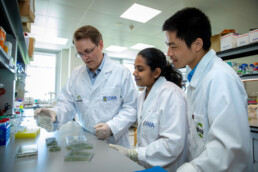
The University of Western Australia (ISC Plants for Space Node) is one of five Australian universities to receive a $90 million funding boost to create food and medicines for space explorers.
The Australian Government is providing $35 million for the new Australian Research Council Centre of Excellence in Plants for Space, led by the University of Adelaide, with additional funding and in-kind support from 38 partner organisations bringing the total value to $90 million.
The UWA node of the program is led by three WA Scientist of the Year Award winners including Professor Harvey Millar, Professor Ryan Lister and Professor Ian Small, all from UWA’s School of Molecular Sciences. Professor Lister is also from the Harry Perkins Institute of Medical Research.
Professor Millar said UWA would receive a grant of more than $7 million for its part in the project. He said the centre would help establish a long-term human presence in space.
“Long-term off-Earth habitation is on the horizon but the success of these missions depends on having medicine and nutritious food without the need for resupply missions from Earth,” Professor Lister said.
“Requiring light, water, carbon dioxide, and minimal nutrients, plants are the ultimate solar-powered biofactories for supporting human nutrition and health, as well as production of useful materials.”
“We’ll develop plant varieties and production systems for pick-and-eat plants like water spinach, tomatoes and strawberries,” Professor Millar said.
“We’ll also develop food plants for long-term space nutrition using duckweeds that are one of the fastest growing plants.”
Professor Small said the space work had spin-off benefits for agriculture on Earth and would help reduce the sector’s carbon footprint.
“Many of the challenges needed for long-term life on Moon and Mars are also faced by agriculture on Earth and need to be researched to advance the efficiency of plant-based foods for example increasing fertiliser use efficiency,” Professor Small said.
Head of UWA’s International Space Centre, Associate Professor Danail Obreschkow said the research would lead to significant benefits to life on Earth.
“A large portion of the food required for nutrition, oxygen and wellbeing will need to be produced en route so it’s essential we solve this problem for the continued exploration of our solar system and there will be major benefits also for life on Earth,” Associate Professor Obreschkow said.
MEDIA REFERENCE:
Cecile O’Connor (UWA Media & PR Advisor) 6488 6876
Fastest ground to airborne vehicle data transfer rate achieved.

How fast can data transfer from ground to an airborne vehicle in free space? 100GB/s – or the equivalent of 100 SD movie downloads *per second*!
Our friends at ICRAR have been published in the journal Nature Scientific Reports, demonstrating the highest ever free space data transfer rate involving an airborne vehicle – one moving at LEO satellite speeds. By solving the atmospheric turbulence issue that has plagued this medium, the team has opened the way for potentially supporting missions such as Artemis, and further exciting research into fundamental physics. Previous space communications have been limited to radio bandwidths.
The ISC is proud to have this team from ICRAR as one of its members. This following media release posted with permission from the ICRAR website.
A team of Western Australian researchers have found a way to avoid the need to use radio transmitters in critical communications, using new technology featuring super-fast optical lasers. Radio transmitters, which are still in use, were developed over a century ago.
The researchers, from the International Centre for Radio Astronomy Research (ICRAR), have been working on this project for two years, with their findings published overnight in the internationally respected science journal, Nature Scientific Reports.
Although optical communications have been in use since the 1980’s, government and industry have continued to rely on radio transmission technology in settings such as satellite communications due to atmospheric turbulence. Atmospheric turbulence causes laser beams to drift away from their intended target.
While there have been advances in the use of optical wireless communication in recent years, this WA discovery addresses the turbulence issue, by using a very fast steering mirror that can correct for turbulence at a rate of hundreds of times per second.
This means that superior optical wireless transmission can be used in more settings, reducing the need for reliance on slower radio transmission.
Lead researcher Dr Shane Walsh explains how his team have found a way to use optical communications to fix upon a rapidly moving target in a turbulent environment, with an uninterrupted, high-speed signal.
“This is a culmination of more than two years of research and testing and takes ground to space communications from what was effectively a ‘dial up’ speed in turbulence to a super-fast ‘broadband’ speed.
“I am proud that our WA team of researchers has been able to contribute a piece of this critical communications puzzle, combining existing research with our team’s specialist expertise,” he said.
The team’s discovery was put through its paces using a drone, which simulates a rapidly moving target. As a next step, the researchers plan to test the technology with a higher altitude aircraft and ultimately a spacecraft, in low earth orbit.
Researchers are now developing a purpose built, optical communications ground station in WA which, when complete, will allow them to further develop and commercialise the technology. It is expected to be used by industry and governments alike, in applications as diverse as communications with spacecraft, meteorology, defence and disaster management.
About ICRAR
The International Centre for Radio Astronomy Research (ICRAR) was founded in 2009 to support Australia’s bid to host the world’s largest radio telescope, the Square Kilometre Array, representing one of the largest scientific endeavours in history.
Constituting a joint venture between Curtin University and the University of Western Australia, and proudly supported by the Government of Western Australia, ICRAR has grown into an internationally renowned, multi-disciplinary research centre for science, engineering and data intensive astronomy, and is one of the top 5 astronomy centres in the world.
Our prize-winning team of 135 researchers from more than 32 countries includes an ARC Laureate Fellow, several ARC Future Fellows, and several Forrest Fellows.
Our Translation and Impact team works closely with industry, government and communities to share our wealth of expertise and to help business grow.
More than half of ICRAR projects involve partnerships with international research institutions, and approximately 300 scientific papers are published annually in prestigious peer reviewed journals.
To learn more, visit icrar.org
ENDS
Media contact: Sharon Segler, Manager Strategic Engagement and Communications
- 0409 20 22 55
- Sharon.Segler@uwa.edu.au
Space Boot Camp showed diversity and breadth of options in space careers
Space Boot Camp Launches Careers
Congratulations to the latest cohort of Space Boot Camp cadets, who enthusiastically participated in our space activities across three days, for the 2022 Space Boot Camp.
With thanks to support from the Australian Space Agency and the Fogarty Foundation, 80 students delved into lectures on Our Universe, Plants in Space, Space Law, How We Use Satellites, and Humans in Space by UWA experts and ex-NASA professionals. On Day One, they were lucky enough to participate in creating ammonium-nitrate powered rocket launches of their own, with UWA Aerospace. Day Two saw a Lunar Habitat Design Workshop with the Chair of Architecture at UWA’s School of Design.
The final day of Space Boot Camp entailed two industry excursions – to First Mode, and Fugro Spaarc. Students got to see space careers and technology in action, launching their own pseudo-Mars Rover Landings off a 10m cherry picker, and touring Fugro Spaarc’s new facility in robotics automations – learning what mission operations look like for both terrestial and space missions.
With this latest round of graduates, the International Space Centre has now prepped 140 cadets for a career in space – and we can’t wait to see their futures.
Space Apps Challenge at UWA uses NASA's open source space data to solve real world problems
Using NASA data to solve real world problems.

Making inventive solutions to real-world challenges using NASA data from space? Count us in!
The ISC, in collaboration with Space Hub Perth, UWA Venture and silver sponsor AROSE, will be hosting the local version of NASA’s Space Apps Challenge, encouraging collaborative approach to problem solving where teams aim to produce solutions to NASA defined challenges that we currently face here on Earth and in space.
Who Can Participate?
Absolutely anyone! Space is for everyone. If you have a background or are just interested in business, entrepreneurship, science, art, history, engineering, design, law, technology, mathematics, education, health, sports, performing arts, hospitality, automotive mechanics or many other areas, then you’re perfect for this hackathon. And no, you don’t have to know how to code, although you can if you want to.
Details
Team Size
Team size should be a maximum of 6 people. You can form your own team or we can help you find one.
Under 18 years old?
Not a problem. We want to you register for the challenge and amaze us with your ideas. However, we do recommend that you do so with a parent or legal guardian (i.e. they should also register).
Mentors
We’ll have mentors available over the weekend to help you select your challenge, determine your problem, guide you with your thinking about your solution and help you present your project. Mentors will come from industry (space & other), academia and government. Their skill sets, knowledge based and industry experience cover a broad range of areas including science, space, entrepreneurship, marketing, problem analysis, design, communications and outreach, photography, social services, health, resources and many more. Space really is for everyone.
Prizes
We’ll have a bunch of prizes for winning teams in Perth, with the top team also advancing to the Global Nomination Round where NASA will select global finalists. We’ll update the details of the prizes soon, so check back here regularly.
More information
Check out the official page and sign up at NASA Space Apps Challenge Perth.
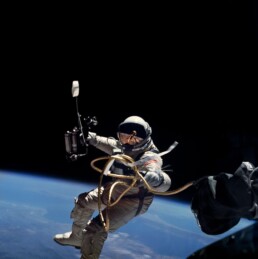
Space Boot Camp September '22

The International Space Centre (ISC) is holding a 3-day Space Boot Camp from 27 to 29 September 2022.
This a great opportunity for Years 9 and 10 students to meet space experts who have worked with NASA and UWA researchers driving WA’s space frontiers. This Space Boot Camp is designed to provide a range of inspirational and interactive sessions that also help students understand their future education and career options.
At the Space Boot Camp, we cover a broad range of topics from space plant biology, law, rocketry and propulsion, and even designing lunar habitats. The students will be involved in a number of interactive sessions including building and launching their own rockets with the UWA Aerospace Club. They will also learn about human physiology in space, growing plants to support long-term missions, space debris (and whose problem it is), space robotics and space career options in WA. Look out for the new and exciting sessions that we have included in the third day!
The Space Boot Camp will be held on UWA campus in Nedlands for the first two days and on the third day the students will be participating in interactive sessions and site tours with industry partners in Perth city. Relevant details, permission slips and further details will be confirmed after registration and payment.
Our last Space Boot Camp was extremely popular and sold out fast – so don’t miss out! In the meantime, if you have any further queries, please do not hesitate to contact us at isc@uwa.edu.au.
Registration can be made at https://payments.uwa.edu.au/internationalspacecamp.
Phantom Galaxy revealed through radioactive space dust
Thanks to Dr Brent Groves from the International Centre for Radio Astronomy Research and the International Space Centre, who has demystified the Phantom Galaxy images in the mid-infrared range from recent James Webb Space Telescope data.
Which part of this beautiful galaxy would kill us if it were near Earth? 😳

